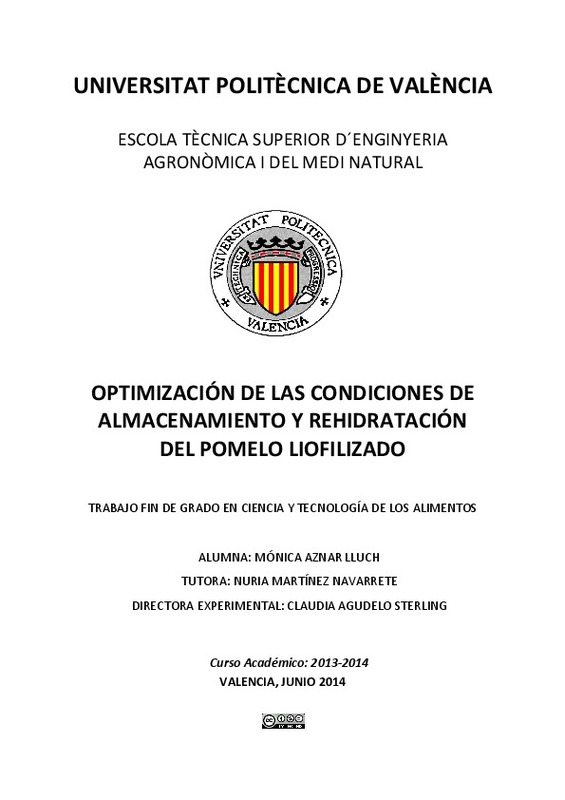|
Resumen:
|
[ES] Se ha estudiado la influencia de la formulación del pomelo para su liofilización en la
selección de las condiciones de almacenamiento de los productos liofilizados, con el fin de
maximizar la calidad del producto ...[+]
[ES] Se ha estudiado la influencia de la formulación del pomelo para su liofilización en la
selección de las condiciones de almacenamiento de los productos liofilizados, con el fin de
maximizar la calidad del producto en polvo. Así mismo, se ha estudiado la viabilidad de su
rehidratación para la obtención de un zumo. Uno de los productos formulados, el que se ha
llamado óptimo 1, se preparó añadiendo al pomelo un 1,27% de goma arábiga y un 0,76% de
fibra de bambú y llevando la mezcla a una humedad del 74%. El otro producto, llamado óptimo
2, incorporaba sólo 1,27% de goma arábiga y la mezcla se llevó a una humedad del 90%.
Después de la liofilización, el óptimo 1 presentó una menor pérdida de compuestos
funcionales y actividad antioxidante. Tras la liofilización, ambos óptimos fueron
acondicionados a humedades relativas del 13, 23, 43 y 68%. La isoterma de sorción y el
diagrama de estado elaborado evidenció que unas condiciones adecuadas para el
almacenamiento de ambos productos a 20ᵒC no deberían franquear los bajos valores
obtenidos de humedad y actividad de agua críticas, cuyos resultados se situaron en un
intervalo de 1,9-2,8 g agua/100 g de producto y 0,0632-0,0955, respectivamente. En este
sentido se recomienda, para este producto, su almacenamiento en refrigeración. A 8ᵒC, por
ejemplo, se permitirían condiciones de humedad relativa de hasta un 17,5% para el óptimo 1 y
23,6% en el óptimo 2. El aumento de las reacciones de deterioro a niveles de humedad altos,
especialmente los alcanzados a aw por encima de 0,43, se observó sobre las diferentes
muestras a partir de un descenso de su contenido en vitamina C y fenoles, flavonoides y
carotenoides totales y de la actividad antioxidante y a través de una modificación del croma y
luminosidad de los productos hacia colores más oscuros y menos puros. Con respecto a la
capacidad de rehidratación que muestran estos productos, el pretratamiento de
deshidratación, al inactivar enzimas, favorece el color, pero al dificultar la solubilización de
compuestos aumenta la viscosidad del producto obtenido. Esto se puede mejorar aumentando
la temperatura de rehidratación.
[-]
[EN] The influence of the formulation of grapefruit to select storage conditions of freeze-dried
products, in order to maximize the quality of the powder has been studied. Also, the feasibility
of obtaining rehydrated ...[+]
[EN] The influence of the formulation of grapefruit to select storage conditions of freeze-dried
products, in order to maximize the quality of the powder has been studied. Also, the feasibility
of obtaining rehydrated juice was studied. One of the formulated products, which has been
called optimal 1, was prepared by adding 1.27% gum arabic and 0.76% bamboo fiber to the
grapefruit and leading the mixture to a moisture content of 74%. The other product, called
optimal 2, incorporated only 1.27% of gum arabic and the mixture was brought to a humidity
of 90%. After freeze-drying, the optimal 1 showed a lesser loss of functional compounds and
antioxidant activity. After freeze-drying, both optimal products were conditioned at relative
humidities of 13, 23, 43 and 68%. The sorption isotherm and state diagram showed that
suitable conditions for the storage of both products at 20ᵒC should not cross the low values
obtained for critical water and water activity, the results of which were placed in a range of 1.9
- 2.8 g water/100 g product and from 0.0632 to 0.0955, respectively. In this respect, this
product is recommended for refrigerated storage. At 8ᵒC, for example, conditions of relative
humidity up to 17.5% for the optimal 1 and 23.6% for the optimal 2. A loss in the functional
compounds and antioxidant activity and modification of the chrome and lightness of the
products toward darker and less pure colors at high humidity levels, especially those at aw
above 0.43, were observed. With respect to the ability of these products for rehydration,
dehydration pretreatment, by inactivating enzymes, supports color, but by impeding
compounds solubilization increases the viscosity of the product obtained. This aspect may be
improved by increasing the temperature during rehydration.
[-]
|







